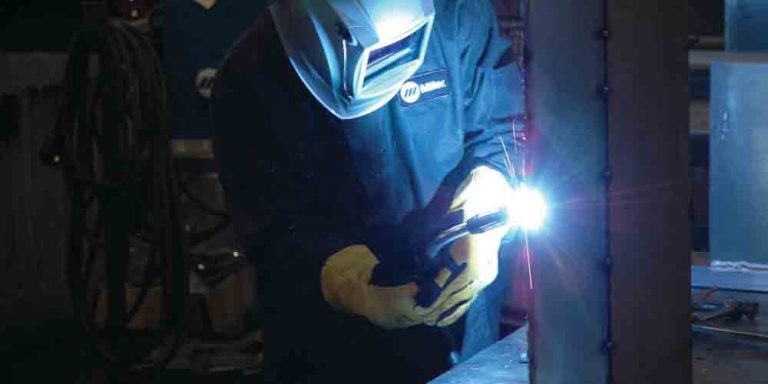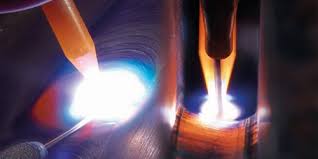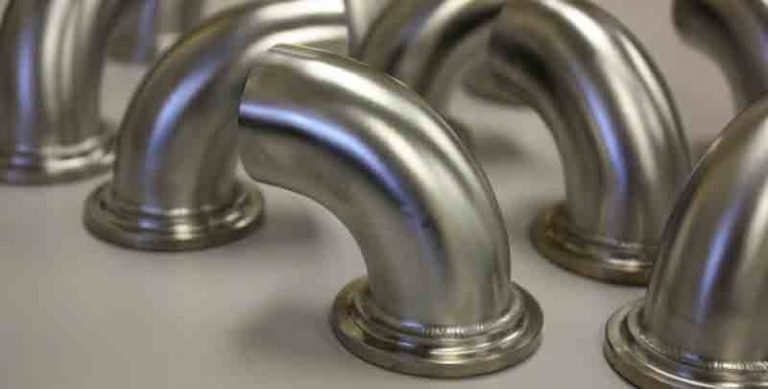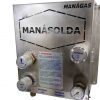
Complete Guide to Gas Mixers and its various applications
What would be the most suitable gas or gas mixtures to weld stainless steel?
Welding Stainless Steel - What is the best shielding gas to weld stainless steel?
What is the best shielding gas to weld stainless steel?
The proper choice of gas or gas mixture to weld stainless steel is of utmost importance for a successful welding.
The use of stainless steel has grown significantly in the past decade in the world. Welding processes in stainless steel have been growing in several segments, such as pharmaceutical, food, nuclear energy, …. As the use of stainless steel grows, so does the number of consumables for welding this material. As stainless steels are used in applications other than carbon steels, welding parameters also differ.
TABLE OF CONTENTS:
1. WELDING STAINLESS STEEL – WHAT WOULD BE THE BEST SHIELD GAS OR SHIELD GAS MIXTURE?
The two main types of alloys in this class of stainless steel are the austenitic types (containing chromium and nickel – 300 series alloys) and ferritic (containing only chromium – 400 series alloys). Each alloy, austenitic or ferritic stainless steels, has unique properties – and different welding requirements.
The shielding gas used in MAG (GMAW) welding, gas metal arc welding, tubular wire electric arc welding (FCAW), or gas tungsten arc TIG welding (GTAW), can have a significant impact on the properties and weld quality, as well as the productivity of the welding operation. The many functions of a shielding gas range from protecting the melted weld pool from the atmosphere to controlling the type of metal transfer and arc stability achieved during welding. To make the proper choice of shielding gas, it is necessary to understand the demand for each welding process in each stainless steel alloy.
To weld austenitic stainless steel alloys, it is very important to consider factors such as chemical reactions, solidification of the melt pool at acceptable levels of productivity and finish of the bead (color and shape of the weld).
The gas mixtures used to join stainless steels often contain argon because of their inert nature, their ability to withstand easy arc starting and their spray-type metal transfer method. For some welding processes, helium can be added to conduct more heat to the base metal, increase weld penetration and improve the melt puddle fluidity. This can lead to higher travel speeds, less part distortion and an overall reduction in welding cost.
In the MAG welding process with tubular wire, oxygen and carbon dioxide (CO2) the mixture of shielding gases is added in order to improve the stability of the arc and the fluidity of the fusion pool. In specific cases, nitrogen or hydrogen can be added in small amounts to refine the weld properties and improve the appearance of the austenitic stainless steel bead. Typically, ternary gas mixtures are the most suitable choice for stainless steel welding.
To select a shielding gas or shielding gas mixture, it is necessary to determine the materials to be welded, the welding process and the composition of the filler metal. Below, we detail the shielding gas mixtures available for stainless steel and the respective welding processes.
2. MAG (GMAW) WELDING FOR AUSTENITIC STAINLESS STEELS

2.1 BINARY GAS MIXTURES
For MAG welding in stainless steel, the most common binary gas mixtures combine argon with oxygen or argon and carbon dioxide (CO2), being suitable for transfer by conventional or pulsed spray.
For applications that require high corrosion resistance, mixtures of Argon and Oxygen in low concentrations (1 to 2%) can produce a spray-like metal transfer. As a negative effect, welds generated in this process have a resistant oxide coating, which may require cleaning after welding.
Argon (Ar) and carbon dioxide (CO2) gas mixtures produce less surface oxide, good shape and cord wetting, wide penetration and consistent quality.
As the amount of CO2 in the gas mixture influences the carbon content of the weld, mixtures with a lower CO2 content (2 to 5 percent) are generally preferred by users.
Increases in travel speed of up to 25% can generally be achieved with mixtures of 5% CO2 with argon in balance, considering the same application with mixtures combined 1% of oxygen with argon in balance.
2.2 TERNARY GAS MIXTURES
Most ternary gas mixtures work well for short-circuit, spray and pulsed spray transfer and provide excellent welding characteristics and high productivity. Argon with additions of 25 to 35% helium and 1 to 2% CO2 can provide an increase of 20% or more in the displacement speed in relation to most binary gas mixtures, improve the control of the distortion of the material with less thickness and optimization of the shape and color of the weld bead. This mixture is an appropriate choice for welding stainless steel with carbon steel (AWS 309) using pulsed spray transfer.
For 300 series stainless steel (austenitic), it is possible to obtain the ideal color and shape of the weld bead with gas mixtures combined argon with CO2-hydrogen. The reducing atmosphere produced by the addition of 1 to 2% hydrogen minimizes the oxide on the surface of the cord and helps to improve fluidity and penetration.
For years, the industry standard gas mixture for stainless steel short-circuit welding was the ternary gas mixture based on helium (85 to 90%), with small additions of argon (5 to 10%) and CO2 (2 to 5%). The combination of argon with 2 to 5 percent CO2 and 2 to 5 percent nitrogen produces good shape and color of the cord in the short-circuit transfer, improving speed and productivity by about 20 percent. The performance of this mixture is almost equivalent to other ternary mixtures for spray transfer and pulsed spray welding of most austenitic stainless steels.
In order to guarantee the formation of an appropriate microstructure, gas mixtures containing nitrogen must be used with caution when welding stainless steel to carbon steel.
3. MAG (GMAW) WELDING FOR FERRITIC STAINLESS STEELS
Ferritic stainless steels are used when greater resistance to corrosion is required, but the cost of chromium/nickel austenitic grades cannot be justified. For example, ferritic stainless steel has become the material of choice for automotive exhaust systems. The muffler, the resonator and the exhaust pipe are areas particularly vulnerable to corrosion from the inside (fuel combustion condensate) and from the outside (exposure to sea air).
Many alloys of ferritic stainless steels, including 409 and 439, are generally welded using MAG welding process with solid electrodes or metal core to produce corrosion resistant parts.
3.1 GAS MIXTURES
The control of the carbon content of the weld, required by various automotive manufacturing standards, can be achieved by properly combining the filler wire with the atmosphere generated by the mixture of shielding gases. To avoid carbon capture in the weld metal, ferritic stainless steels are welded using mixtures of gases with argon / oxygen for spray transfer and pulsed spray welding.
This approach minimizes the increase in carbon in the weld, but can reduce the speed of displacement of the weld.
Depending on the maximum permitted level of carbon, gas mixtures of argon with 5 to 10% CO2 generally produce an acceptable chemical formation and microstructure of weld in ferritic stainless steel. These mixtures can improve welding speed and productivity in most applications.
Although these gas mixtures can be used with solid wires or with a metal core, the chemical formation of the weld can be more easily adapted to provide better control over the heat input in the weld and the penetration of the bead, considering the use of wires with metal core. This is important when welding thin materials, normally found in automotive applications. While ternary mixtures can further improve performance, mixtures of binary gases containing argon and carbon dioxide meet or exceed most requirements for ferritic stainless steels.
3.2 GREATER PRODUCTIVITY WITH SHIELD GASES AND WIRE EXCHANGE
A major automotive parts manufacturer has evaluated various metal/shielding gas/core wire combinations to produce a critical flexible coupling for an automotive exhaust systems. The required circumferential weld joined a mixture of base materials of alloy 409, 304, 321 and INCONEL®. The main objective was to reduce defects to improve part acceptance rates and welding speeds. The cost reduction was essential with the improvement of quality.
CASE STUDY
CASE 1 – solid wire with high silicon content and extra low carbon content, diameter of 0.035 inches (0.9 mm) and protective atmosphere formed by the combination of argon and oxygen.
CASE 1 PRODUCTIVITY – Welding of 3 unities per minute.
CASE 2 – 0.045 inch (1.2 mm) diameter chrome/niobium core wire f used for welding with various gas mixtures containing different concentrations of argon/CO2;
CASE 2 PRODUCTIVITY – Welding of more than 5 unities per minute
In case 2, the metal-core wire, with its higher deposition rate for the same current level, provided excellent wetting characteristics and a wide arc shape, resulting in a flat cord shape with acceptable penetration. Little or no post weld rework was required to meet the end customer’s specifications.
4. TUBULAR WIRE WELDING FOR AUSTENITIC STAINLESS STEELS AND FOR FERRITIC STAINLESS STEELS

Flow-filled wires are developed for use with specific shielding gas compositions. For austenitic stainless steels, the choice is 100% CO2 or 75% argon/25% CO2. The slag coverage in the weld limits the absorption of carbon, allowing the use of a protective atmosphere with a high CO2 content.
The process for choosing the most suitable gas mixture depends mainly on the welding position and operating conditions. An argon/CO2 mixture generally offers the widest range of operations and facilitates the welder’s job. For welding with tubular wire, the gas mixture containing 25% CO2 with argon in balance offers good control for welding out of position and a reduced distortion rate compared to a shielding of 100% CO2.
5. TIG WELDING (GTAW) FOR AUSTENITIC STAINLESS STEELS AND FOR FERRITIC STAINLESS STEELS

Shielding gases for TIG welding include pure argon, mixtures of argon/helium and argon/hydrogen (only for austenitic alloys). As seen in the other welding processes, also for TIG welding in austenitic and ferritic steel, the selection of the shielding gas is based on productivity, specification of dimensional stability of the part (distortion) and aspect/color of the weld bead.
For stainless steel TIG welding, argon is used more widely as it provides excellent arc initiation and low thermal conductivity, making it suitable for welding parts with reduced thickness. It is suitable for manual welding, because changes to the torch at work have little impact on the operating voltage and melting in thin materials is limited.
In the gas mixture with argon balance, the addition of up to 50% helium or hydrogen (up to 5% for manual welding) increases the thermal conductivity of the protective atmosphere, allowing for faster welding speeds (increases from 50 to 100%) and greater productivity. In addition, higher travel speeds help to reduce part distortion.

When the TIG weld on 300 stainless steel alloy needs to maintain the original color of the part, the hydrogen reducing effect in an argon / hydrogen mixture helps to decrease the residual oxide in the weld deposit, minimizing or eliminating the need for post- welded. As the thickness of the base metal increases, the hydrogen or helium content of the argon mixture must increase to obtain the desired weld bead appearance and shape.
6. CONCLUSION
The definition of the shielding gas or shielding gas mixture is of utmost importance for proper welding on stainless steels. In most ferritic and austenitic stainless steel welding applications, argon/CO2 mixtures can help improve productivity and performance, especially if conventional and pulsed spray transfer techniques are used. When the appearance of the bead is important, ternary mixtures, (three gases combined) can provide excellent results and also help to reduce welding costs.
QUESTIONS related to “WHAT IS THE BEST SHIELDING GAS TO WELD STAINLESS STEEL?”
Any questions and comments related to “What is the best shielding gas to weld stainless steel ?”, please feel free contact us at any time. In addition, please take this opportunity to explore our product line of high performance gas mixers for TIG welding (GTAW welding).

Gas mixer designed and manufactured for the welding process, which allows mixing between 02 gases, with flow rate and outlet pressure control. From 0 to 100% content adjustable gas mixing output.

Compact gas mixer designed and manufactured for the welding process, which allows mixing between 02 gases, with outlet flow rate control. From 0 to 100% content adjustable gas mixing output. Requires cylinder/first stage pressure regulators for both input gases.
